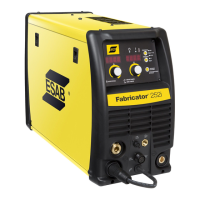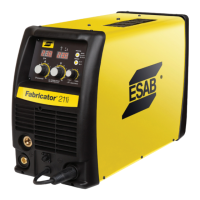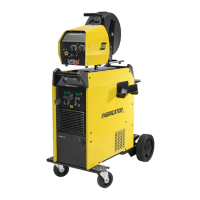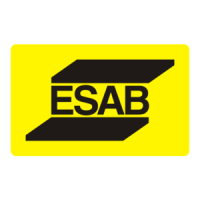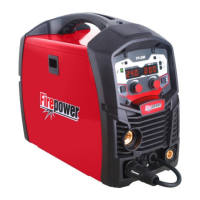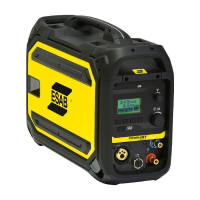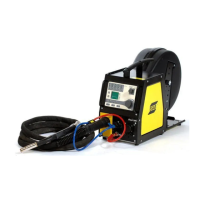ESAB FABRICATOR 141i
TROUBLESHOOTING AND SERVICE 5-2 Manual 0-5420
FAULT CAUSE REMEDY
6 Inconsistent wire feed. A Fouled contact tip. A Replace Velocity contact tip if
necessary.
B Drive roll tension not tight
enough.
B Tighten drive roll tension.
C Worn feed roll. C Replace.
D Excessive brake tension on wire
reel hub.
D Reduce brake tension on spool
hub
E Worn, kinked or dirty conduit
liner.
E Clean or replace conduit liner
7 No gas flow in MIG mode. A Gas hose is damaged. A Replace or repair.
B Gas passage contains debris. B Disconnect gas hose from the rear
of Power Source and blow out
debris.
C Shielding gas cylinder valve shut
off.
C Turn on the cylinder.
D Flowmeter/ Regulator turned off. D Turn on flowmeter/ regulator.
E Empty gas cylinder. E Replace gas cylinder.
8 Gas flow continues after
the torch trigger switch
has been released (MIG
mode).
Gas valve has jammed open due
to debris in the gas or the gas
line.
Have an accredited ESAB service
provider repair or replace gas
valve.
9 Power indicator will not
illuminate and welding arc
cannot be established.
The Electricity supply is
inadequate.
Ensure that the Electricity Supply
voltage is within 95-140 VAC.
10 TIG electrode melts when
arc is struck.
TIG Torch is connected to the (+)
polarity terminal.
Connect the TIG Torch to the (-)
polarity terminal.
11 Arc flutters during TIG
welding.
Tungsten electrode is too large
for the welding current.
Select the correct size of tungsten
electrode. Refer to Table 4-7.
Table 5-1
5.02 Routine Service
WARNING
There are extremely dangerous voltage and power levels present inside this Power Source. Do
not attempt to open or repair unless you are an accredited ESAB Service Provider. Disconnect
the Welding Power Source from the Electricity Supply Voltage before disassembling.
Routine Inspection, Testing & Maintenance
The inspection and testing of the Power Source and associated accessories shall be carried out in accordance with Section 5 of EN
60974-1: Safety in Welding and Allied Processes-Part 2 Electrical. This includes an insulation resistance test and an earthing test to
ensure the integrity of the Power Source is compliant with ESAB's original specifications.
If equipment is to be used in a hazardous location or environments with a high risk of electrocution as outlined in EN 60974-1,
then the above tests should be carried out prior to entering this location.
A. Testing Schedule
1. For transportable equipment, at least once every 3 months; and
2. For fixed equipment, at least once every 12 months.
The owners of the equipment shall keep a suitable record of the periodic tests and a system of tagging, including the date of
the most recent inspection.
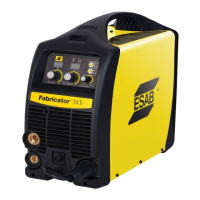
